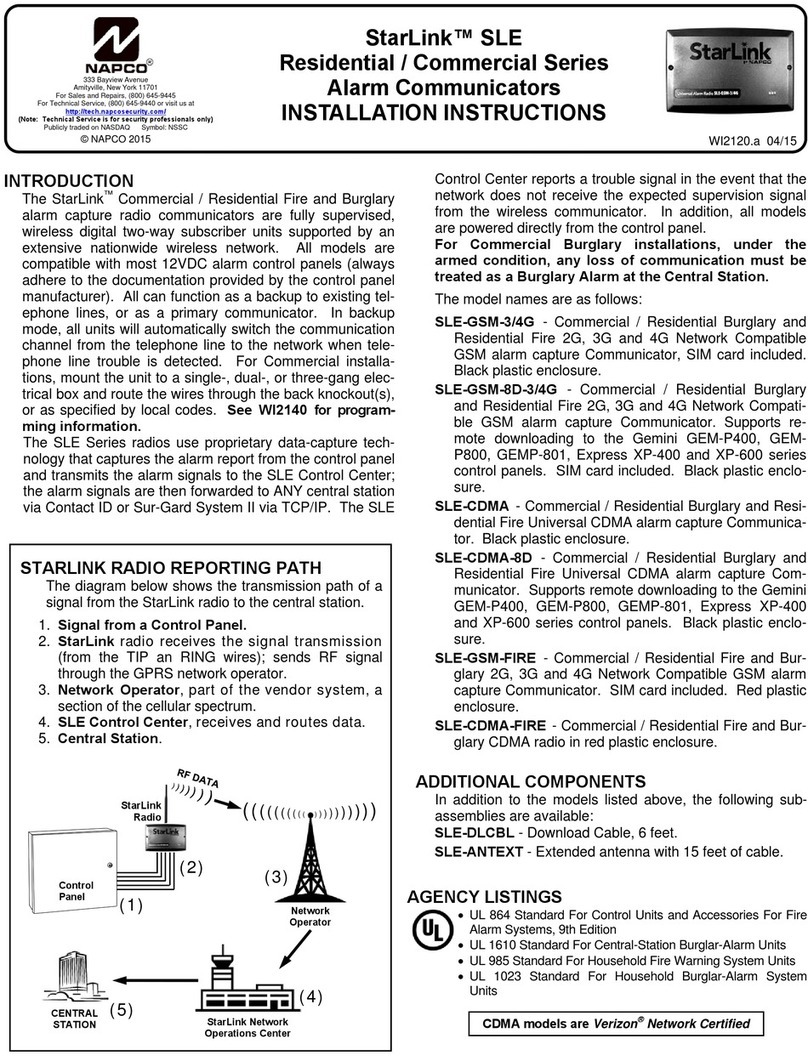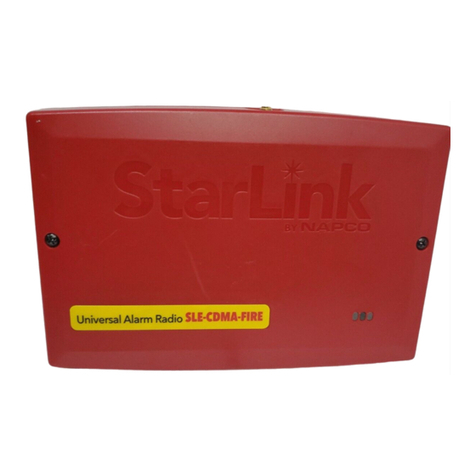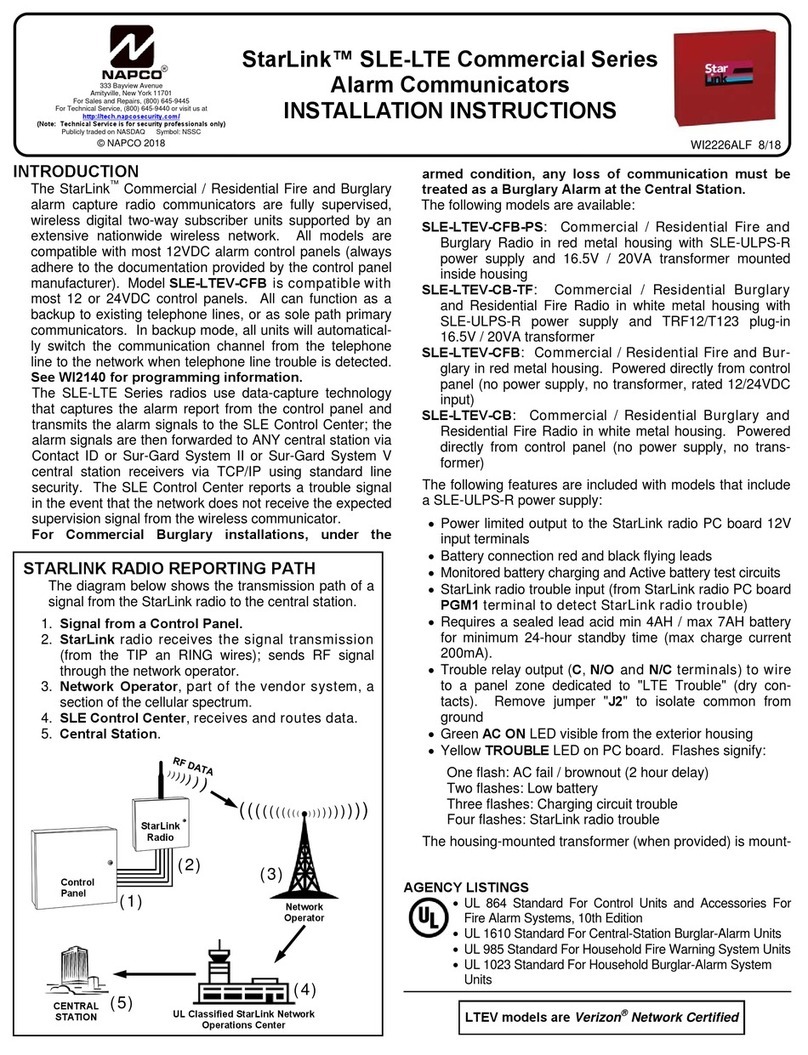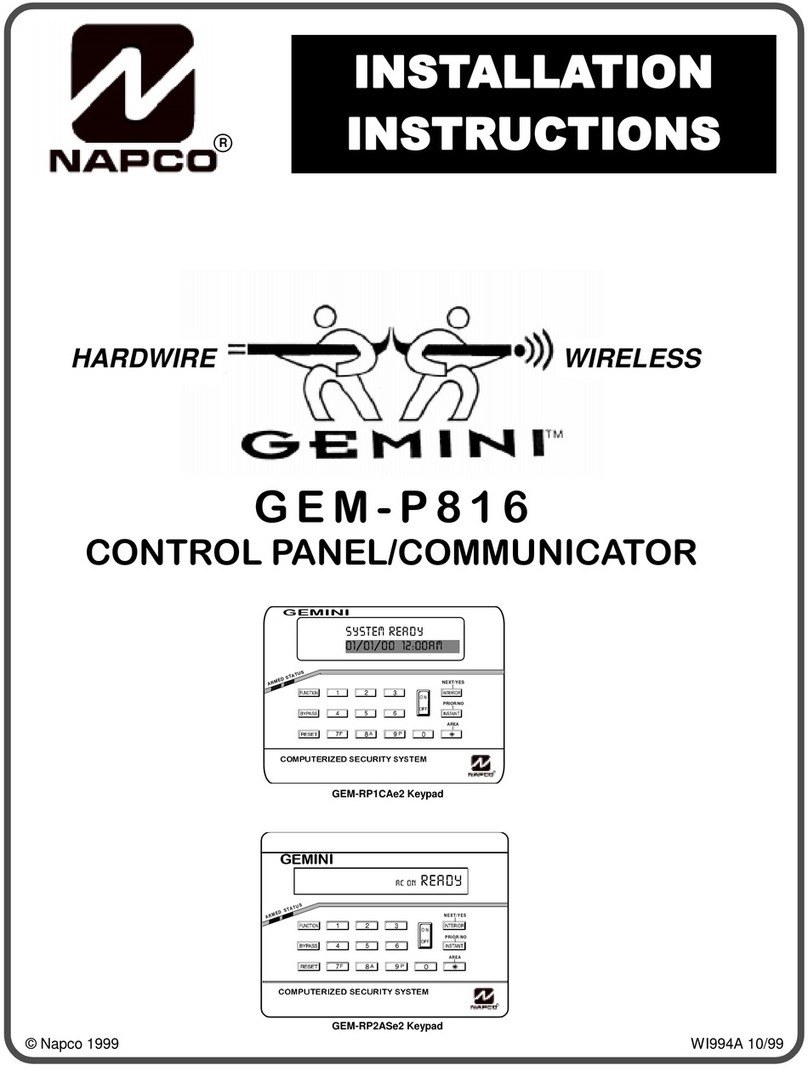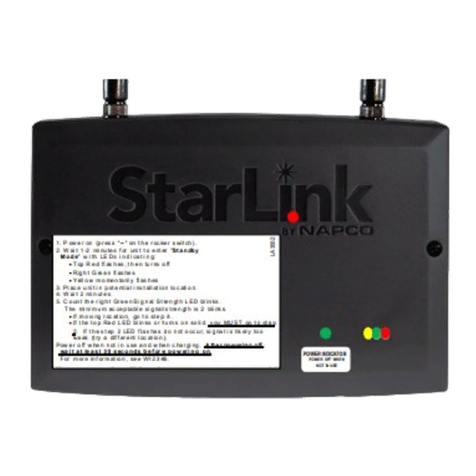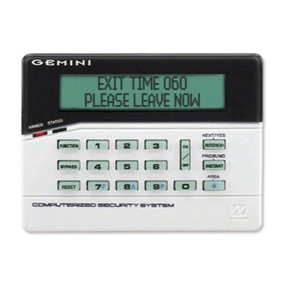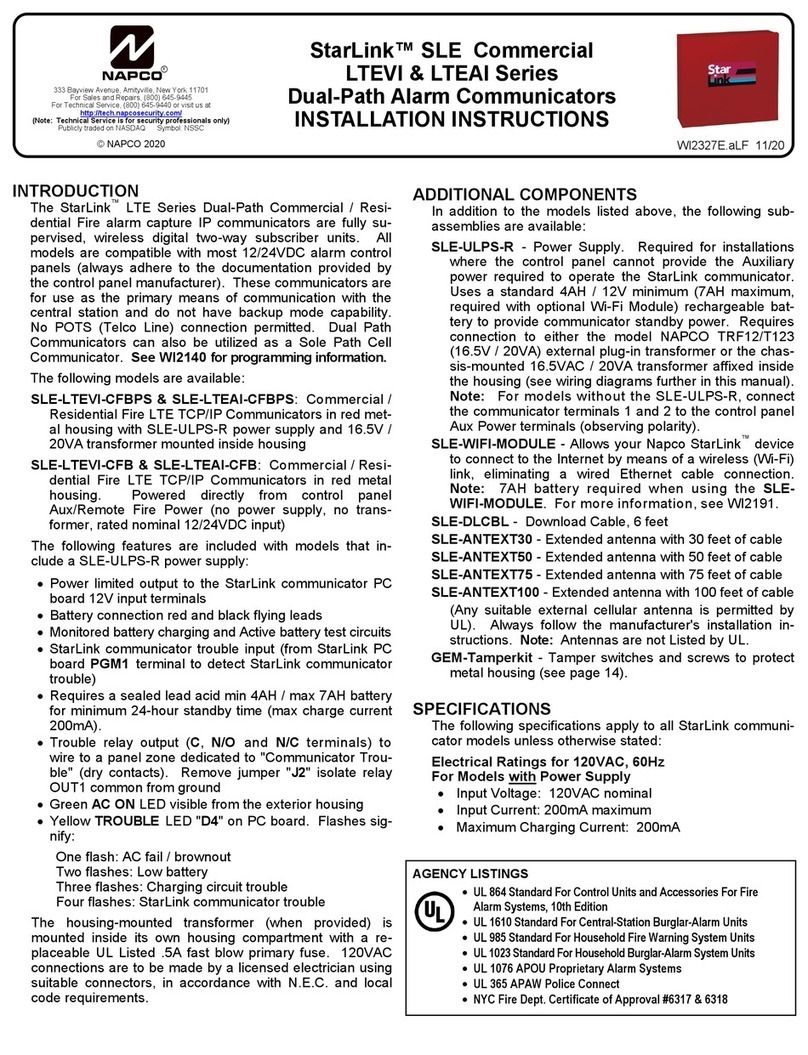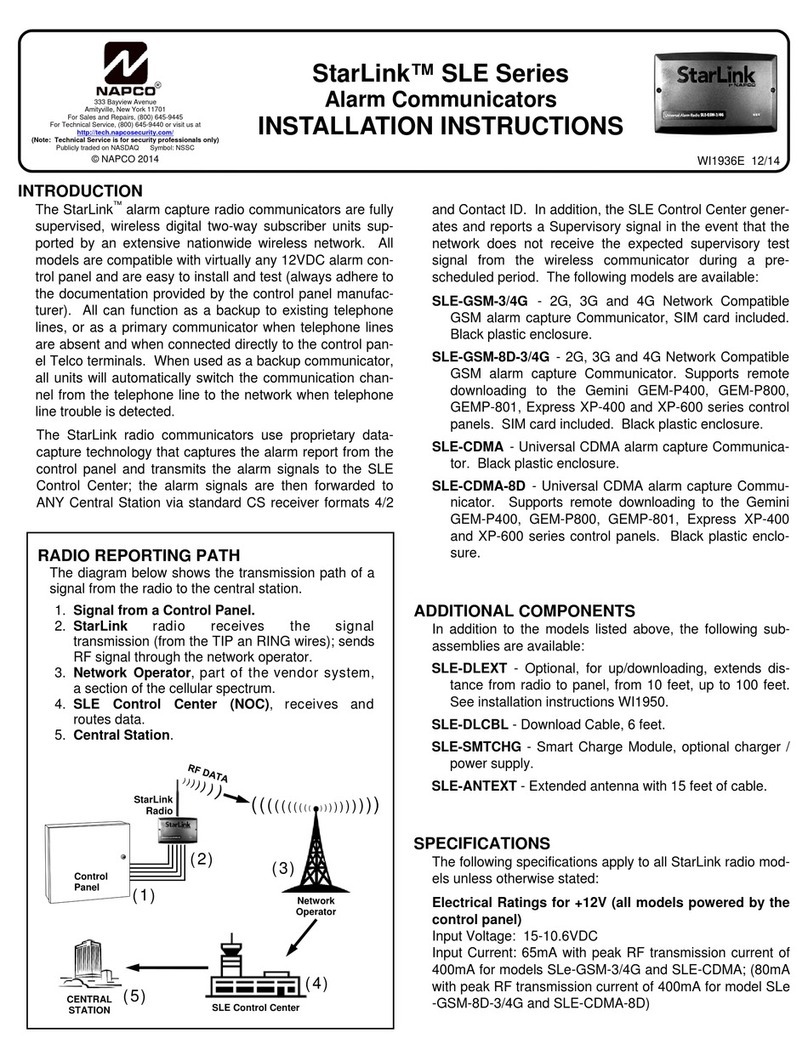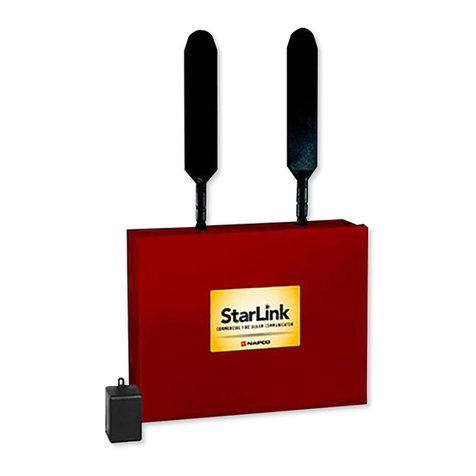
6StarLink™ SLE-LTEVI-FIRE & SLE-LTEAI-FIRE Commercial Series Dual-Path Alarm Communicators -- Installation Instructions
page 5. Note: These event codes and zone numbers can
be changed from the Management Center screen (located at
www.NapcoNOC.com).
Upon alarm, the NOC can optionally send an SMS message
to a third party that includes the appropriate Contact ID
alarm code, including the zone or user number, if applicable.
The "STARLINK RADIO RELATED EVENT REPORT
CODES" table also includes the most common Contact ID
alarm codes.
Programming StarLink Radio Troubles
It is required that if a StarLink radio or control panel trouble
is detected, that it is reported to the central station.
When the StarLink radio detects and sends a trouble to the
control panel, the control panel must be programmed to
annunciate this trouble. The radio can detect multiple trou-
bles as indicated by the "Red Trouble LED" ("D5"). For
these troubles to be annunciated at the control panel, there
are several methods, some of them are configurable at the
Management Center screen (www.NapcoNOC.com):
Wire the radio OUT1 relay to a dedicated control panel
zone (input) to annunciate the trouble. Two wiring options
are available:
Activate the trouble with an open by wiring the
EOLR in series with the Common and N/C of the
OUT1 relay;
Activate the trouble with a short by wiring the
EOLR in parallel with the Common and N/O of
the OUT1 relay
The radio must also report this trouble to the central station.
With NAPCO GEMC series control panels, wire the zone as
indicated in the wiring diagrams further in this manual.
Optionally, the FACP trouble relay can be used to trigger a
report to the central station.
Wire the FACP trouble relay to IN2; Common and N/O ter-
minals in parallel with a 10K EOLR. With Gemini C-Series
(GEMC) control panels, we recommend using the Fire Aux
Relay. Program the Fire Aux Relay to activate as a trouble
relay. Wire this relay to the StarLink module IN 2 terminal;
by wiring the EOLR in parallel with Common and N/O of the
OUT1 relay. Note: We recommend using the text
"Radio Trouble" as the Zone Description.
StarLink Radio Supervision
If the two Telco wires (DACT interconnect wiring to the ra-
dio) between the StarLink radio and the control panel are
cut or otherwise disconnected, the control panel must de-
tect and generate a local trouble indication. Program the
control panel for telephone supervision. Program the Star-
Link radio using the Management Center Advanced Fea-
tures screen (at www.NapcoNOC.com) to enable Tip/
Ring Wiring Fault Report. Refer to wiring diagram.
Supervision Time Schedule Considerations
If a status change (alarm trouble, etc.) is transmitted, the
radio supervision timer is restarted.
For example, if a status change is sent, the next regular
supervision transmission will occur at the interval deter-
mined by your rate plan.
Configuration Download / Firmware Updates
Technician on site required.
For Commercial Installations a technician is required to be
STEP 5: SIGNAL VERIFICATION
After triggering channels, use the StarLink radio Signal
Verification to ensure that the StarLink radio Network has
properly received the signals.
Verify Online: To verify that the signals have been
received by the StarLink radio Network online, go to
www.NapcoNOC.com, log in with your Username and
Password, enter your Company ID number and the
StarLink Radio Number, then click Signal Log.
IMPORTANT: Verify that the signals transmitted by t he
StarLink radio have been properly received by your central
station before leaving the premises.
NOTE: This equipment has been tested and found to
comply with the limits for a Class B Unintentional Radiator,
pursuant to Part 15 of the FCC Rules. These limits are
designed to provide reasonable protection against harmful
interference in a residential installation. This equipment
generates, uses, and can radiate radio frequency energy
and, if not installed and used in accordance with the In-
struction Manual, may cause harmful interference to radio
communications. However, there is no guarantee that in-
terference will not occur in a particular installation. If this
equipment does cause harmful interference to radio or tele-
vision reception, which can be determined by turning the
equipment off and on, the user is encouraged to try to cor-
rect the interference by one of more of the following
measures: 1. Reorient or relocate the receiving antenna;
2. Increase the separation between the equipment and re-
ceiver; 3. Connect the equipment into an outlet on a circuit
different from that to which the receiver is connected; 4.
Consult the dealer or an experienced radio/TV technician
for help.
NAPCO GEMINI C-SERIES (GEMC)
CONTROL PANEL PROGRAMMING
To program the central station receiver reporting format,
use PCD-Windows Quickloader download software. Open
the Digital Communications screen, Central Station Re-
ceivers tab, as shown in the following image:
A "Point ID" (also called "Contact ID") receiver format pro-
gramming example:
The radio can transmit to any central station capable of
receiving SIA Contact ID or 4/2 via DACR technology or
the DSC Sur-Gard Model System II or Sur-Gard System V
central station receivers, Bosch D6100IPV6 or Bosch
D6600 Receiver (with ITS-D6686 Ethernet Adapter) via
TCP/IP using standard line security.
Note: A receiver reporting format must be entered for
each telephone number used, but each telephone number
may be assigned a different format.
CAUTION: The installer should always be certain an
area code is programmed into the control panel.
Optional: If you wish the StarLink radio to report a code
and zone number (Contact ID by default) to the central sta-
tion in response to a triggered input event, see the table on
